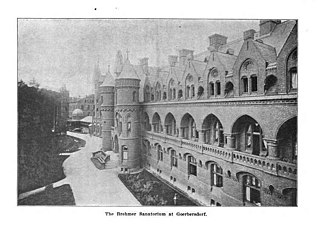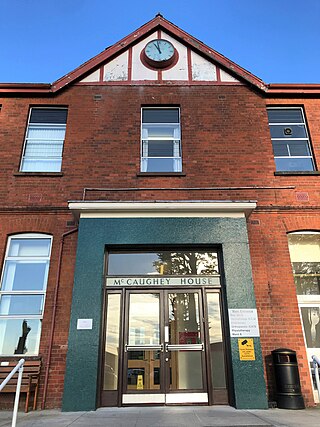
A sanatorium, also sanitarium or sanitorium, are antiquated names for specialised hospitals, for the treatment of specific diseases, related ailments and convalescence. Sanatoriums are often in a healthy climate, usually in the countryside. The idea of healing was an important reason for the historical wave of establishments of sanatoriums, especially at the end of the 19th- and early 20th centuries. One sought, for instance, the healing of consumptives, especially tuberculosis or alcoholism, but also of more obscure addictions and longings of hysteria, masturbation, fatigue and emotional exhaustion. Facility operators were often charitable associations such as the Order of St. John and the newly founded social welfare insurance companies.

The Waverly Hills Sanatorium is a former sanatorium located in the Waverly Hills neighborhood of Louisville, Kentucky.
A preventorium was an institution or building for patients infected with tuberculosis who did not yet have an active form of the disease. Popular in the early 20th century, preventoria were designed to isolate these patients from uninfected individuals as well as patients who showed outward symptoms. Philanthropist Nathan Straus opened the first preventorium on Preventorium Road in Lakewood, New Jersey in 1909.
Sunshine Way is the name of a crescent-shaped street in Mitcham, England, built in 1936 for families from overcrowded areas of inner London, and including specially-designed houses to suit the needs of tuberculosis (TB) patients.

Glen Lake Sanatorium, a tuberculosis treatment center serving Hennepin County in Minnesota, opened on January 4, 1916, with a capacity of 50 patients, and closed in 1976. In 1909, the Minnesota State Legislature had passed a bill authorizing the appointment of county sanatorium boards and appropriating money for the construction of county sanatoriums. Glen Lake Sanatorium was the fifth of fourteen county sanatoria that opened in Minnesota between 1912 and 1918. Glen Lake was the first U.S. tuberculosis sanatorium to be accredited by the American Medical Association.The sanatorium had its own post office, and the mailing address was Glen Lake Sanatorium, Oak Terrace, Minnesota, until the surrounding area was incorporated into the City of Minnetonka.
The estate Zonnestraal is a former sanatorium in Hilversum, the Netherlands. The building was designed by architects Jan Duiker Bernard Bijvoet and Jan Gerko Wiebenga, and is an example of the Nieuwe Bouwen. In 1995, the estate was submitted to UNESCO's list of World Heritage Sites, but it was ultimately not listed.

The Seaside is a historic medical facility at 36 Shore Road in Waterford, Connecticut. It is nationally significant as the first institution designed for heliotropic treatment of children suffering from tuberculosis. Its buildings "comprise an exceptional collection of fully realized and generally well-preserved Tudor Revival-style institutional architecture", which were designed by Cass Gilbert. The property was listed on the National Register of Historic Places in 1995.
Hermann Neufert was a German educator who founded the world's first open air school, and the international movement which followed.
Waldschule für kränkliche Kinder was the first open air school, built in Westend of Charlottenburg, Germany in 1904 by Walter Spickendorff, a city architect. The school was founded by the pediatrist Bernhard Bendix and Berlin's school inspector Hermann Neufert. It led to the beginning of the open air school movement which quickly spread across Europe and North America. Approval for the school was granted by the local authority in June 1904 and it opened on August 1. Spickendorff designed the school to provide the most exposure to the sun. The school took its name from its situation within a pine tree forest, the Grunewald, part of Germany's capital since 1920.
The town of Colorado Springs, Colorado, played an important role in the history of tuberculosis in the era before antituberculosis drugs and vaccines. Tuberculosis management before this era was difficult and often of limited effect. In the 19th century, a movement for tuberculosis treatment in hospital-like facilities called sanatoriums became prominent, especially in Europe and North America. Thus people sought tuberculosis treatment in Colorado Springs because of its dry climate and fresh mountain air. Some people stayed in boarding houses, while others sought the hospital-like facilities of sanatoriums. In the 1880s and 1890s, it is estimated that one-third of the people living in Colorado Springs had tuberculosis. The number of sanatoriums and hospitals increased into the twentieth century. During World War II, medicines were developed that successfully treated tuberculosis and by the late 1940s specialized tuberculosis treatment facilities were no longer needed.

Ethan Allen School for Boys was a reform school in Delafield Town, Wisconsin which operated in a former tuberculosis sanitorium from April 1959 until June 2011, when it was abolished and the inmates moved to Lincoln Hills School in Irma. It was operated by the Wisconsin Department of Corrections.

The former Dispenser's House of Diamantina Hospital is now the heritage-listed Diamantina Health Care Museum at Cornwall Street, Woolloongabba, City of Brisbane, Queensland, Australia. It was designed by Thomas Pye of the Queensland Government Architect's Office and built in 1908 by W Chaplain. It was added to the Queensland Heritage Register on 3 July 2007.
Jakob Bernhard Bendix was a German pediatrist. He studied medicine from 1883 to 1888 at Frederick William University in Berlin, at Alma mater Lipsiensis in Leipzig and Albert Ludwig University of Freiburg where he got his doctoral degree. Between 1891 and 1894 he worked as an assistant physician at internist and orthopaedic university hospital in Germany's capital Berlin. From 1894 to 1899 he became Attending physician under the leadership of famous Otto Heubner. In 1901 he qualified as an associate professor, in 1907 he responded to a call as an adjunct professor of Charité in Berlin. He published several medical books and articles of pediatrist topics. His focus was infancy. In 1910 he became the author of a pediatrist standard book for students and physicians which was translated in several languages.

The Firland Sanatorium was Seattle's municipal tuberculosis treatment center. It opened on May 2, 1911, and closed on October 30, 1973.
The Wooroloo Sanatorium and Cemetery is located on Linley Valley Road, Wooroloo, Western Australia. The Sanatorium operated from 1914 until transferred to Department of Corrective Services in 1970. The cemetery opened in 1915 and continues to operate.

Sully Hospital was a psychiatric hospital in Sully, Vale of Glamorgan, Wales. It has since been converted into luxury apartments and remains a Grade II* listed building.

Ken Worpole is a writer and social historian whose many books include works of literary criticism, architectural history, and landscape aesthetics, and was one of the editors of the 2001 United Nations Centre for Human Settlements (UNCHS) report, The State of the World’s Cities. In 2005 The Independent newspaper stated that: ‘For many years, Ken Worpole has been one of the shrewdest and sharpest observers of the English social landscape.’ In 2014 ICON Review similarly observed that ‘For well over 40 years Ken Worpole has been one of the most eloquent and forward thinking writers in Britain.’

Whiteabbey Hospital is a hospital located close to the village of Whiteabbey, within the town of Newtownabbey, Northern Ireland. The hospital first opened in 1907 as The Abbey Sanitorium, centred around a country house known as 'The Abbey'. The house has stood on the site from 1850, and was once the residence of prominent architect Charles Lanyon. The hospital was extended and several buildings added throughout the early 20th century, and it was renamed Whiteabbey Hospital in 1947. The hospital is managed by the Northern Health and Social Care Trust. Many healthcare services have been withdrawn from the hospital, most recently with the closure of the Minor Injuries Unit in 2014.

Open-air treatment is the therapeutic use of fresh air and sunshine. In a hospital or sanitorium, this may be done by ensuring good ventilation in an airy, sunny room or by housing patients outdoors in tents or other open forms of accommodation. During the 20th century, such treatment was used for people with infectious respiratory diseases such as influenza or tuberculosis.

Tuberculosis Preventorium for Children in Lakewood Township, New Jersey was the first preventorium in the United States. It opened in July 1909, as an expression of Nathan Straus' desire to prevent the spread of tuberculosis among children. The children were selected mainly by the Association of Tuberculosis Clinics and were passed upon by the Department of Health of New York City. There were 32 of these clinics, to the nearest of which the parents applied. No discrimination was made as to race or creed, and there was no charge for transportation or board.

















